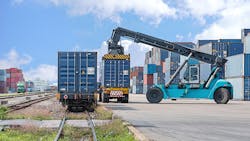Intermodal’s Future Is Secure, But Growth Will Remain Slow for Now
The future of intermodal transportation in the United States faces good news and bad news. Or perhaps we should say, good news followed by bad news.
Speaking at this year’s Intermodal Expo annual trade show held by the Intermodal Association of North America (IANA), economists and other industry experts predicted the industry will enjoy healthy growth for most of 2017, before being swept up with everyone else in the next recession.
Sharing a view of a looming recession that is similar to one held by other economists is Noel Perry, managing director of transportation consulting firm FTR. If the duration seen in historical cycles of growth and recessions hold, we are living in the tail end of a weak economic recovery that has lasted for seven years, he told the Expo attendees.
Perry, who is a former executive with Schneider National and CSX, said the weak recovery will continue in the near term but will begin to slow down late next year. “We’re living on borrowed time historically, so we have to be very wary,” he observed. “Until that happens, next year will be a lot like this one, so don’t expect much help from the economy any time soon.”
It doesn’t feel like a recovery if you are in the freight transportation business right now, but one reason for that is it was never a particularly robust recovery, with growth haphazard and never posting big gains, he explained. “We’re in a recovery even though it doesn’t seem like it to a lot of people because freight always suffers as a recovery matures,” he observed.
In addition, he noted that by the end of 2017 truckload haulers will face cost pressures arising from a renewal of the driver shortage, which abated over the past year. Fleet operators will need to deal with costly federal truck safety regulations like the electronic logging device mandate, and they need to add 50% more drivers before the end of next year. All of this will contribute to driving up truckload rates, which will benefit intermodal in the short term, he observed.
However, the eventual recession will submerge all boats, Perry predicted, even if it will be mode-agnostic. “It is likely to be difficult times for intermodal and trucking. If we have a recession, traffic won’t come back quickly. Very likely your volumes won’t be much higher than they are now.”
The upside is that while the current economic recovery has been weak, Perry and other analysts believe the next recession will not involve anything near the precipitous drop like we experienced in 2008. While a new recession awaits, he doesn’t think it will last very long. “When we meet again in 2020 we will be in another recovery,” he asserted.
Domestic intermodal could use some relief from the beating it took this year. Total intermodal traffic volume registered an overall volume loss of 4.6% in the third quarter, IANA reported. This followed overall intermodal traffic recording its first volume decline in 25 consecutive quarters of growth in the second quarter, when it saw a loss of 6.1%.
The seven highest-density trade corridors—accounting for 63.6% of total intermodal volume—collectively dropped 3.9% year over year, IANA reported. The Midwest-Northwest corridor saw a 3% gain in traffic, dominated by containers. All other corridors posted declines.
“The Q3 results were in line with the previous quarter, reflecting sluggish market conditions,” IANA’s president Joni Casey observes. “Projections for 2017 are more optimistic, based on continued increases in consumer spending and expectations that the international side of the equation will stabilize.”
Vicious Cycle Continues
Intermodal marketing companies (IMCs)—the third-party providers who broker both intermodal and truckload freight—fared better than the intermodal industry in general because of the clear gains they made in the highway sector, the association pointed out.
Because excess trucking capacity drove down truckload rates, highway volumes reported by IMCs were up 14.6% from the previous year. However, intermodal loads handled by IMCs fell 11.6%, creating a net result of a total volume decrease of 0.1%.
This follows an all too common pattern: When the truckload segment has a cough, domestic intermodal gets a cold. When truckload rates fall during a period of softness in the market, shippers tend to abandon the intermodal, and freight shifts to over-the-road trucking. When truckload rates rise, more shipments move back to intermodal.
That softening appears to have reached its terminus as truckload rates begin to rise. This is largely due to the fact that consumer spending began to rise later in the year, and the fact that shippers who were drawing down inventories appear to have completed that process.
A softer truckload market hurting intermodal has always been the pattern, but does it always have to be this way?
Decades ago an intermodal executive looking over his industry quipped, “Intermodal has a great future ahead of it—it always has and it always will.” Looking over today’s industry we would expect that this person would be astonished at its progress, and unfortunately, also would notice how many of the same barriers to growth remain.
One problem is that all intermodal movements involve different parties, each of which must be paid and all of whom must operate at maximum efficiency for the system to work. Speaking at this year’s Intermodal Expo, BNSF’s executive chairman Matt Rose compared intermodal transportation to a relay race in which everyone from dockworkers to trucking companies play essential roles. Left unmentioned was that if his metaphor applies, then all you need is for one runner to drop the baton to lose the race.
Rose and other Class 1 rail executives at this year’s Expo declared they are seriously committed to growing their intermodal business, a seriousness of purpose that has been created by the near evaporation of their previous cash cows: coal and oil hauling.
The Association of American Railroads noted that intermodal has grown from 27.3% percent of rail traffic in 1990 to 49% in 2015. But over the same period coal traffic dropped from 29% of total railcar loads to just 18.3%.
Because intermodal is the only traffic segment that is growing for them, the railroads have committed enormous amounts of money to building the infrastructure needed to support it.
However, customer service is not exactly something freight railroads are famous for. Because of the need to manage an enormous and complex physical infrastructure and widely spread out operations, it’s hardly surprising their focus tends to be inward and operationally oriented.
The major reason IMCs play such a prominent role in intermodal is that years ago the railroads closed down their sales departments, shifting that function to these third-party providers. When the railroads deal directly with intermodal shippers these days, it usually involves demurrage charges.
But as one shipper observed during the Expo, it’s difficult for him to sell intermodal to his upper management when a railroad refuses to negotiate or compromise on what sometimes are massive demurrage charges.
There are a lot of factors that make intermodal transportation in the U.S. sometimes resemble a potato sack race more than an Olympic relay competition. Ports and port labor are working to keep from becoming a major choke point in the system. Drayage carriers continue to struggle with the driver shortage, union-inspired assaults in the independent contractor model and chassis mess.
Yes, intermodal still has a great future ahead of it, and many improvements are visible. Lengths of haul where intermodal is viable have shrunk from 1,500 to 500 miles, and in some lanes to as low as 150 miles for UPS.
Domestic intermodal even plays a role in e-commerce today. UPS has been the railroads’ No. 1 customer for many years, and Amazon is now believed to be No. 2. While logistics experts have focused on the last-mile dilemma, companies operating in the retail e-commerce space are scattering smaller distribution centers around the country and stocking inventory there to make sure their customers won’t be disappointed by promises of fast delivery.
“The use of intermodal will grow by UPS. Rail sits in the middle of every market we serve,” observed Kenneth Buenker, vice president of corporate transportation services for UPS, who predicts that intermodal will play a bigger role in e-commerce in the future.
For that to happen service needs to improve, said Steven Van Kirk, executive vice president to intermodal for the third-party logistics provider Transplace. “For intermodal to grow you need to deliver the level of quality services that won’t drive e-commerce companies away.” He also said he sees a major opportunity for intermodal in reverse logistics, which plays a bigger role in e-commerce than in other businesses.
The intermodal service improvements needed don’t necessarily involve speed, Van Kirk said. “People want reliability. Taking a day or two out of the movement is not necessarily a good thing if you can’t deliver that.”
In the meantime, supply chain managers and their IMC and 3PL warehouse service providers are looking to technology to drive inefficiencies out of the system. We will fill you in more about some of these developments soon.
About the Author

David Sparkman
founding editor
David Sparkman is founding editor of ACWI Advance (www.acwi.org), the newsletter of the American Chain of Warehouses Inc. He also heads David Sparkman Consulting, a Washington D.C. area public relations and communications firm. Prior to these he was director of industry relations for the International Warehouse Logistics Association. Sparkman has also been a freelance writer, specializing in logistics and freight transportation. He has served as vice president of communications for the American Moving and Storage Association, director of communications for the National Private Truck Council, and for two decades with American Trucking Associations on its weekly newspaper, Transport Topics.
